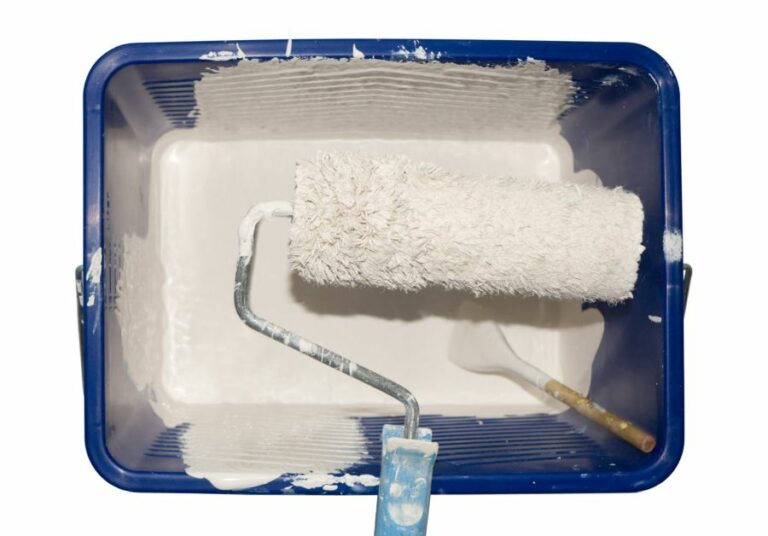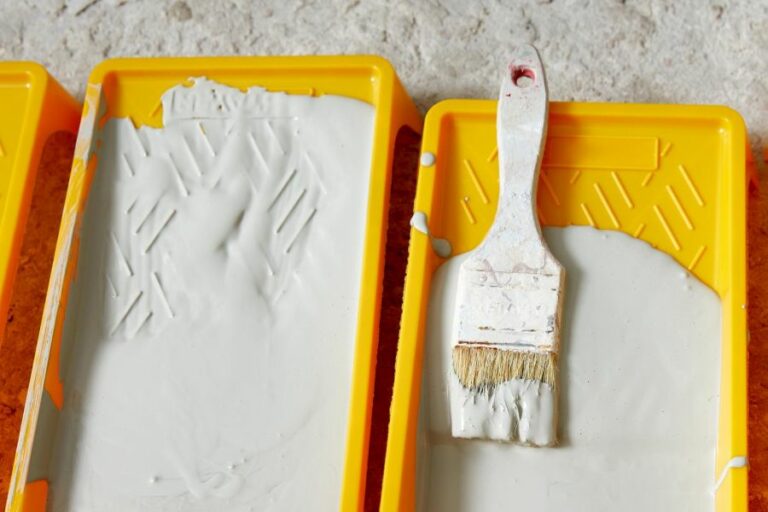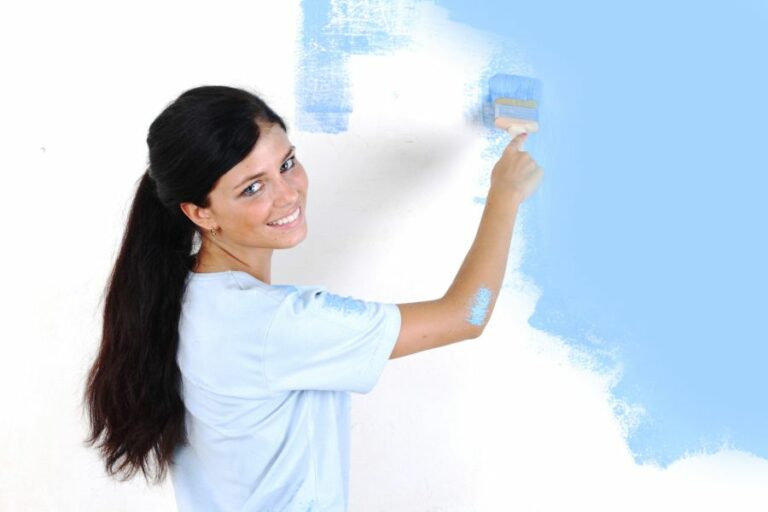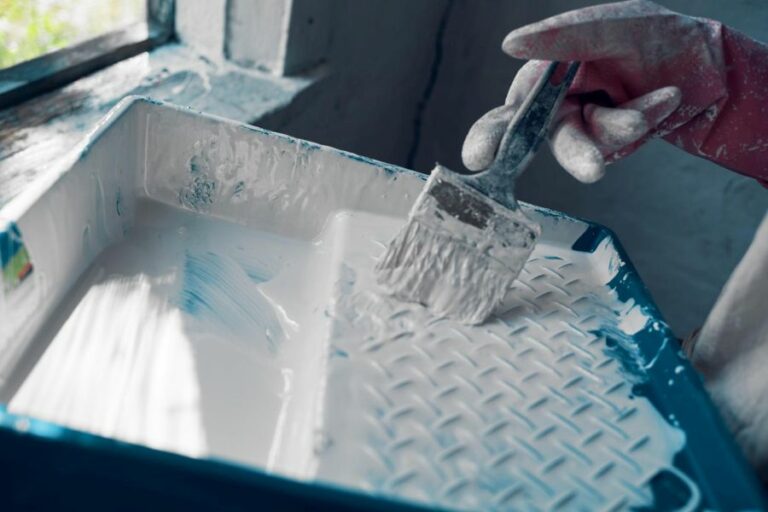Matte Paint For Interior Walls, 25 Things You Should Know
Are you considering giving your interior walls a fresh, stylish look and feel? Matte paint is the way for a sophisticated, subtle appearance with a luxurious touch. Matte paint has been a go-to option for many interior designers and homeowners in recent years. As an expert in the field, I’m eager to tell you everything you need to know about matte paint and how it can transform your space in ways you never imagined.
Matte paint for interior walls:
Matte paint is a non-reflective finish commonly used on interior walls, providing a flat and smooth appearance. It suits residential and commercial spaces, offering enhanced aesthetics, hiding imperfections, reduced glare, and a forgiving application process. However, it has lower durability and can be challenging to clean compared to glossier finishes.

Ready to switch things up in your home? Discover the wonders of matte paint for interior walls. Unveil the unique aesthetic, benefits, and application tips this versatile finish offers. Read on and be inspired to transform your space like never before.
Contents
- 1 Interior Wall Matte Paint Options
- 2 Evaluating Wall Benefits of Matte Paint
- 3 Matte vs. Flat: Choosing Interior Wall Paint
- 4 Matte or Eggshell for Interior Wall Finishes
- 5 Wall Suitability for Flat Matte Paint
Interior Wall Matte Paint Options
• What is Matte Paint?
Matte paint is a type of paint finish that has a flat, non-reflective appearance. It is commonly used on interior walls in residential and commercial spaces. The finish is created by adding a flattening agent to standard paint, which scatters light in multiple directions to reduce sheen.
• Benefits of Using Matte Paint
– Enhanced Aesthetics
Matte paint offers a sophisticated and understated finish to your walls. With its flat and smooth appearance, it can easily blend with various interior styles, making it a popular choice for home and property owners.
– Hiding Imperfections
Due to its ability to absorb light, matte paint does a great job hiding minor wall imperfections such as uneven surfaces, cracks, and bumps. This makes it an excellent choice if you’re trying to conceal wall flaws without extensive repairs.
– Reduced Glare
Unlike glossy finishes, matte paint prevents glare and reflection, making it a suitable option for rooms that receive a lot of sunlight or have bright light fixtures.
– Forgiving Application Process
Matte paint is much more forgiving during the application process, which means it’s easier to touch up mistakes without leaving noticeable marks compared to other finishes.
• Drawbacks of Using Matte Paint
– Lower Durability
Matte paint finishes are more susceptible to scuffs, stains, and general wear and tear compared to glossier finishes. As a result, they may require more frequent maintenance and repainting.
– Cleaning Challenges
Since matte paint is porous and absorbs dirt and moisture more than other finishes, it can be difficult to clean. Rubbing or scrubbing the surface could cause the paint to wear away or become patchy.
• Tips for Painting with Matte Paint
– Choose the Right Primer
It’s essential to use a primer on your walls before applying matte paint. Priming the surface not only ensures better adhesion of the paint but also improves its durability. Choose a high-quality primer that matches the color of the paint for optimal results.
– Use Quality Paint
It’s crucial to select high-quality matte paint from a reputable manufacturer. Cheap paint may result in poor coverage, requiring multiple coats and potentially causing an uneven appearance.
– Apply Multiple Thin Coats
Achieving an even finish with matte paint requires applying multiple thin coats rather than one thick coat. This method ensures better coverage and a more consistent finish. Allow each coat to dry before applying the next coat.
– Use the Right Tools
Using the proper applicators can make a significant difference in achieving a smooth finish with matte paint. I recommend using a high-quality paint roller or brush designed for use with matte paint.
• Recommended Rooms for Matte Paint
– Bedrooms
Matte paint is an ideal choice for bedrooms due to its calming and serene appearance. The lack of glare and reflection makes it a great choice for rooms intended for relaxation and sleep.
– Living Rooms & Dining Rooms
In living and dining rooms, matte paint can evoke a sense of sophistication and elegance. It’s an excellent option for large spaces where you want to feel warm and inviting.
– Ceilings
Matte paint is a popular choice for ceilings, as it helps to minimize the appearance of any imperfections, such as cracks or uneven surfaces.
• Alternatives to Matte Paint
If you’re looking for a wall finish that’s more durable and easier to clean than matte paint, consider the following alternatives:
– Eggshell Finish
Eggshell is a low-sheen paint finish that strikes a balance between matte and glossy. It’s slightly more durable and easier to clean than matte paint, although it may not hide imperfections as well.
– Satin Finish
Satin finishes are commonly used in areas with high traffic, such as hallways or playrooms. They provide a slightly glossy finish that can withstand more wear and tear than matte paint and are easier to clean.
In conclusion, it’s essential to weigh the benefits and drawbacks of matte paint before deciding on the best finish for your interior walls. For additional information on interior wall finishes and paint types, visit the EPA website for guidance.
Evaluating Wall Benefits of Matte Paint
• Understanding Matte Paint Basics
Matte paint, also referred to as flat paint, is a type of paint finish that has a very low reflective quality. This characteristic enables it to effectively conceal minor imperfections on surfaces, making it a popular choice among homeowners and interior designers.
Matte finish paint diffuses light, giving walls a smooth appearance without any shine or gloss.
– Advantages of Matte Paint for Walls
Aesthetic Appeal
Matte paint creates a subtle, elegant, and modern look for walls without the glossiness that can be found in other paint finishes. It delivers a velvety texture that provides depth and warmth to a space.
Due to its ability to absorb light, matte paint can evoke a cozy and intimate atmosphere, perfect for bedrooms or living areas.
Hiding Imperfections
One of the most significant benefits of using matte paint is its capacity to hide minor surface flaws like small cracks or bumps. The non-reflective finish helps conceal these imperfections, making the paint a suitable option for walls that are slightly uneven or with slightly rough textures.
Easy to Touch-Up
Matte paint allows for seamless touch-ups, as the texture and color blend well with the existing paint, making it less noticeable. This feature can be particularly useful for high-traffic areas or walls with children’s artworks.
– Disadvantages of Matte Paint for Walls
Durability Concerns
The main drawback of matte paint is that it is less durable when it comes to everyday wear and tear. It can be more prone to scuff marks, making it a less suitable option for high-traffic areas, such as hallways and entryways.
Cleaning Difficulties
Another disadvantage of matte paint is the challenge of cleaning it. Unlike satin or semi-gloss finishes, matte paint doesn’t have a protective, glossy layer which makes it easy to wipe down.
When cleaning matte walls, you may find that the paint absorbs moisture or that scrubbing too hard can create a shiny spot. This can be problematic in spaces where frequent cleaning is necessary, like kitchens and bathrooms.
• Tips for Using Matte Paint on Walls
– Proper Surface Preparation
To maximize the benefits of matte paint, it is essential to prepare the wall surface correctly. Ensure the surface is smooth, clean, and free of any dirt or debris before applying the paint. You may need to fill in any cracks, smooth out any rough edges, and sand the wall to ensure it is adequately prepared.
– Use a Quality Roller or Brush
When applying matte paint, using a high-quality roller or brush can help ensure an even, consistent finish. A quality applicator can enhance coverage and minimize the need for extra coats.
– Consider Other Finish Options for Certain Areas
If you are concerned about durability and cleaning, it might be appropriate to choose another paint finish for specific areas within your home. For instance, a satin or semi-gloss finish might be more suitable for kitchens, bathrooms, or high-traffic areas.
• Final Thoughts
While matte paint has advantages and disadvantages, it can be a great option for walls if you’re seeking an elegant and cozy atmosphere for your space. It is essential to weigh its benefits against its drawbacks and consider its appropriateness for the specific area within your home.
Proper surface preparation and application techniques are also crucial for achieving the best results with matte paint. For more information about paint finishes and their applications, visit Consumer Reports for comprehensive guides and recommendations.
Matte vs. Flat: Choosing Interior Wall Paint
When it comes to painting the interior walls of your home, there are a variety of factors to consider. Among these factors is the choice between matte and flat paint finishes. Both of these options have their specific advantages and disadvantages.
• Defining Matte and Flat Paint Finishes
Before we delve into the specifics, it’s important to have a clear understanding of what matte and flat paint finishes are.
– Matte Paint
Matte paint has a low sheen, which means it does not reflect light as much as other finishes, like glossy or satin. This results in a smooth, even appearance that can help hide imperfections and create a modern, sophisticated look.
Matte paint is generally easier to clean than flat paint and is ideal for areas with high traffic, such as living rooms and bedrooms.
– Flat Paint
Flat paint, also known as matte finish, has a chalky surface and does not reflect light at all. It provides a completely matte finish, making it ideal for camouflaging surface imperfections. However, due to its lack of sheen, flat paint is difficult to clean and is more susceptible to damage, like scuff marks and stains.
Now that we understand matte and flat paint finishes better let’s explore their specific advantages and disadvantages.
• Advantages of Matte Paint Finish
– Aesthetic Appeal
Matte paint provides a smooth and even appearance that is highly sought-after in modern interior design. Its low-sheen finish can make colors appear more vibrant and saturated, adding depth and dimension to the walls.
– Hiding Imperfections
Due to its low sheen, matte paint is effective at camouflaging minor surface imperfections, such as small cracks and uneven textures. This makes it a popular choice for older homes or those with walls that may need some additional TLC.
– Ease of Cleaning
Although matte paint isn’t as easy to clean as some more glossy finishes, it is easier to maintain than flat paint. Most matte finishes can be wiped down with a damp cloth, ensuring that your walls maintain their clean and pristine appearance.
• Advantages of Flat Paint Finish
– Excellent Coverage
Flat paint has excellent coverage, which means you may require fewer coats when painting your walls. This can result in not only a faster painting project but also reduced overall costs.
– Camouflaging Surface Imperfections
Flat paint is the ideal choice for concealing significant surface imperfections because it does not reflect light. It is particularly suited for walls that have larger cracks, uneven textures, or other visible defects.
– Cost
In general, flat paint tends to be less expensive than other finishes. This can make it a more budget-friendly option for homeowners who are looking to save money on their painting projects.
• Disadvantages of Matte Paint Finish
– Susceptibility to Damage
While matte paint is easier to clean than flat paint, it can still be damaged relatively easily. Scratches, stains, and scuff marks may be more visible on matte paint surfaces, which can make it less suitable for high-traffic areas like hallways and playrooms.
• Disadvantages of Flat Paint Finish
– Difficult to Clean
One of the most significant disadvantages of flat paint is its difficulty in cleaning. Flat paint is porous, which means it can absorb dirt, grease, and other stains, making it extremely difficult to remove. Deep cleaning methods may also cause damage to the paint itself.
– Susceptibility to Marks
Flat paint is more susceptible to marks and scuffs than other finishes, which can cause it to look worn or dirty over time. Flat paint may not be the best choice for high-traffic areas like hallways and children’s rooms.
• Recommendations Based on Experience
Having explored the advantages and disadvantages of both matte and flat paint finishes, I recommend the following:
- Use matte paint for living rooms, bedrooms, and other areas where you want a sophisticated and modern look. Matte paint is also suitable for walls with minor imperfections that could benefit from the camouflaging effect. Remember to exercise caution in high-traffic areas, as matte paint can be prone to damage.
- Use flat paint for walls with significant imperfections that require substantial camouflage. Keep in mind that flat paint is not ideal for high-traffic areas or rooms where you expect a lot of dirt and stains. You might consider using flat paint for ceilings or low-traffic rooms, such as a formal dining room.
As you choose between matte and flat paint finishes for your interior walls, remember to consider the specific needs of your space and carefully weigh the pros and cons of each option. For more professional advice on interior painting, visit the Paint Quality Institute at paintinfo.com. Happy painting!
Matte or Eggshell for Interior Wall Finishes
When it comes to painting interior walls, the choice of paint sheen is as important as the color itself. Two popular sheen options are matte and eggshell. Both have their advantages and disadvantages, and each one complements specific design styles, furniture, and lighting conditions.
• Characteristics of Matte Paint
Matte paint is a flat finish that has no shine, making it an ideal choice for hiding imperfections on walls and ceilings. It is a popular choice for bedrooms and living rooms, as it creates a relaxing and comfortable atmosphere.
– Pros of Matte Paint
- Hides Imperfections: Matte paint is an excellent choice for walls with imperfections, as the flat finish minimizes the appearance of dents, bumps, and uneven surfaces.
- Good for Large Walls: Matte paint is often recommended for large wall areas because it does not reflect light, which can highlight even the smallest imperfections.
- Color Depth: Matte paint allows colors to appear deeper and more saturated on the walls, especially with darker shades.
- Suitable for Artwork: The non-reflective surface of matte paint provides an excellent backdrop for displaying artwork without causing glare or reflections.
– Cons of Matte Paint
- Durability: Matte paint is not as durable as eggshell or other higher-sheen paints. It can scuff, scratch, and mark more easily, making it less suitable for high-traffic areas and households with children or pets.
- Cleanability: Matte paint does not withstand scrubbing or harsh cleaning agents well, making it harder to remove stains and dirt.
• Characteristics of Eggshell Paint
Eggshell paint has a slight sheen that is more durable than matte paint but not as shiny as satin or semi-gloss. It is often used in living areas, hallways, and bedrooms, where a touch of reflected light is desired without too much glare.
– Pros of Eggshell Paint
- Durability: Eggshell paint is more resistant to scuffs, scratches, and marks than matte paint. It is better suited for high-traffic areas, such as hallways or living rooms, where walls encounter more wear and tear.
- Cleanability: Eggshell paint is more washable than matte paint, allowing for easier removal of dirt and stains with a damp cloth or sponge.
- Light Reflectivity: While not as shiny as satin or semi-gloss paint, eggshell does give off a subtle sheen that reflects light, helping to make a room appear brighter.
– Cons of Eggshell Paint
- Imperfections: Eggshell paint may not hide imperfections as well as matte paint due to its slight sheen.
- Application: Eggshell paint can be more tricky to apply than matte paint, as it is less forgiving of uneven roller strokes and brush marks.
• Which One Should You Choose?
When deciding between matte and eggshell paint, the key factors to consider are the room’s purpose, the condition of the walls, and your cleaning habits.
– Choose Matte Paint If:
- You have walls with many imperfections or a textured surface.
- You prefer a cozy, subdued atmosphere with minimal light reflection.
- You are displaying artwork or photography and want to avoid glare.
– Choose Eggshell Paint If:
- You have a high-traffic area or a household with children or pets that require more durable paint.
- You prefer a slight sheen or want to maximize light reflection in a room.
- You need a paint that is easier to clean and maintain.
In conclusion, the best paint sheen for your interior walls depends on your specific needs and preferences. Matte paint is better for hiding imperfections and providing a flat, non-reflective finish, while eggshell paint is more durable, easier to clean, and has a subtle sheen.
Consult with a professional interior design expert or paint store associate to help you determine the best sheen for your specific situation.
Wall Suitability for Flat Matte Paint
• Understanding Flat Matte Paint
Flat matte paint, also known simply as “matte” or “flat,” is a specific type of paint finish that results in a non-reflective, low-sheen appearance. It is a popular choice for walls in many modern homes and has become the go-to finish for those seeking a simple, elegant aesthetic.
Flat matte paint works by evenly distributing color pigments, creating a smooth surface that diffuses light rather than reflecting it. This quality sets it apart from more glossy paint finishes like satin, semi-gloss, or high-gloss.
When deciding whether flat matte paint is the right choice for your walls, numerous factors should be taken into consideration.
• Advantages of Flat Matte Paint
– Visually Pleasing
Flat matte paint offers a soft, even finish that is both visually soothing and attractive. It creates a classy, understated look that can perfectly complement modern, minimalist interior design schemes. With its lack of shine, flat matte paint can create an ambiance of warmth and sophistication in any room.
– Hides Imperfections
One of the reasons why many people choose flat matte paint for their walls is its ability to hide surface imperfections. Since it diffuses light, matte paint is much more forgiving when it comes to minor blemishes, such as small dents, scratches, or uneven texture.
This is particularly useful when painting older walls or those with less-than-perfect surfaces.
– Less Prepping Needed
Due to its ability to camouflage minor imperfections, there is often less need for extensive preparatory work, such as sanding, filling, and priming, when using flat matte paint.
This can be a significant time saver, particularly for busy homeowners or DIY enthusiasts with limited time for home improvement projects.
– Wide Color Range
Flat matte paint is available in a broad array of colors, making it easy to find the perfect hue to suit your design preferences. Whether you want to create a bold accent wall or opt for a subtle, neutral backdrop, matte paint offers endless possibilities.
• Disadvantages of Flat Matte Paint
– Cleaning and Maintenance
Unfortunately, one of the major drawbacks of flat matte paint is its susceptibility to staining and damage due to its porous nature. Unlike glossier finishes, which can be easily wiped clean, flat matte paint is less resistant to moisture and dirt, making it more challenging to keep looking fresh.
While some higher-quality matte paints are now formulated to be more resistant to staining and dirt, they still tend to be less durable than their glossier counterparts.
This can be particularly problematic in high-traffic areas of your home, such as hallways or children’s bedrooms, where walls are more likely to become stained or scuffed.
– Uneven Touch-ups
Another disadvantage of flat matte paint is that touch-ups can sometimes result in an uneven appearance. While this type of paint is excellent at hiding minor imperfections, it can be unforgiving when it comes to blending in fresh paint with the existing finish.
This can lead to patchy, uneven results that may require an entire wall to be repainted.
• Recommendations for Using Flat Matte Paint on Walls
While flat matte paint has its share of drawbacks, it can be an excellent choice for the right circumstances. Here are a few recommendations for making the most of flat matte paint in your home:
- Consider the Room’s Purpose: Flat matte paint is best suited for rooms with low levels of moisture and dirt, such as bedrooms, living rooms, or home offices. It may not be the ideal choice for bathrooms, kitchens, or busy hallways.
- Opt for High-quality Paint: When selecting a flat matte paint, it’s worth investing in a higher-quality, stain-resistant product that will provide added durability and longevity.
- Prepare the Surface: Adequate preparation is key when using flat matte paint. Be sure to clean walls thoroughly and address any significant surface imperfections before painting.
- Choose the Right Colors: When selecting matte paint colors, consider how they will work within your overall design scheme. While matte finishes can hide imperfections, dark colors tend to show them more than lighter shades.
In conclusion, the decision of whether or not flat matte paint is good for your walls comes down to weighing the advantages and disadvantages against your specific needs and preferences. With an understanding of the properties of flat matte paint, you can make an informed decision that best suits your home’s aesthetics and design goals.
For further information on paint finishes and their applications, consider visiting a reputable source like Benjamin Moore’s learning center.







